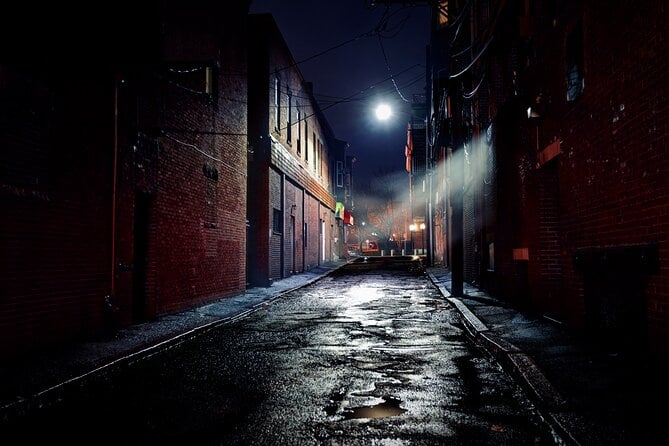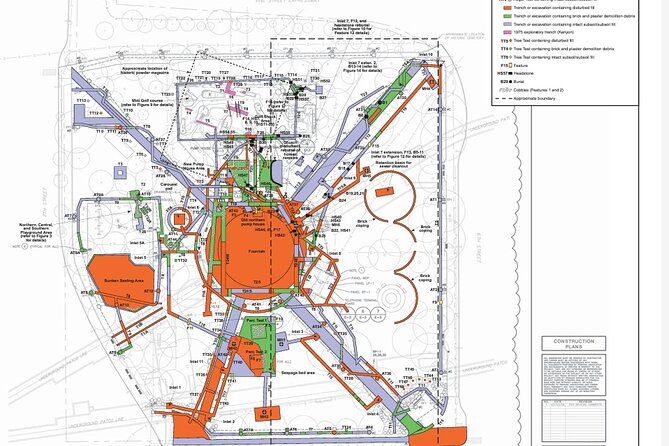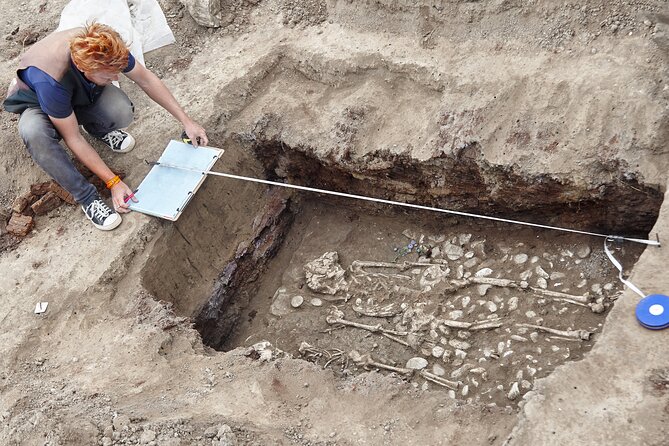Philadelphia’s forgotten dead lie in nameless graves, their stories lost to time and tragedy. Countless individuals, victims of disease, poverty, and neglect, were buried without markers, their identities erased from history. As researchers uncover these lost narratives, a poignant journey emerges, honoring the lives of the marginalized and destitute. Their struggles and legacies, once forgotten, now demand to be recognized and remembered.
Key Points

-
Philadelphia’s history includes the burial of countless "forgotten" individuals, including those who died in epidemics, poverty, and tragedy.
-
Thousands of Philadelphians lie in nameless graves across the city, with many perishing in yellow fever epidemics and paupers buried in unmarked plots.
-
Research and archaeological excavations aim to uncover forgotten tales, shed light on marginalized individuals, and foster a journey of healing and reconciliation.
-
Stories reveal the despair, neglect, and untimely demise of forgotten individuals, with lives and deaths reduced to statistics and consigned to obscurity.
-
Tours seek to memorialize the lives and honor the legacies of the destitute and forgotten dead, ensuring these individuals are no longer forgotten.
A Grim Legacy

Although Philadelphia boasts a rich history, the city also grapples with a grim legacy – the burial of countless "forgotten" individuals.
Thousands languished in pauper’s graves, their identities erased. Epidemics, poverty, and tragedy left many anonymous and forgotten.
Philadelphia’s cemeteries conceal the remains of the destitute, the marginalized, and the unknown. This dark history reflects systemic inequalities that persisted for centuries.
Today, efforts are underway to locate and honor these forgotten souls, but the city’s past reveals a troubling truth – that in life and death, some were left behind, their stories untold.
You can also read our reviews of more tours and experiences in Philadelphia.
The Nameless Graves
Thousands of Philadelphians, long forgotten, lie in nameless graves across the city.
Many perished in the yellow fever epidemics of the 18th and 19th centuries, their identities lost to history. Paupers and strangers were often buried in unmarked plots, their stories untold.
The city’s indigent dead were interred in mass graves, their remains mixed together. Today, the locations of these forgotten cemeteries are obscured, their markers eroded by time.
Beneath bustling city streets and towering skyscrapers, the city’s unclaimed dead continue to rest in quiet, anonymous slumber, their legacies largely unknown.
Unearthing Lost Stories

The Philadelphians who perished in unmarked graves across the city had their stories lost to time, their identities forgotten. Through meticulous research and archaeological excavations, historians and community members sought to uncover these forgotten tales, restoring dignity to the city’s nameless dead.
-
Uncovering the past revealed untold narratives, shedding light on the marginalized and disenfranchised individuals who faced poverty, disease, and social stigma in life, and were denied even a proper burial in death.
-
Giving voice to the voiceless, these efforts aimed to honor the memory of the forgotten, reclaiming their place in the city’s history and collective consciousness.
-
By piecing together the fragments of their lives, the city embarked on a journey of healing and reconciliation, acknowledging the human cost of its past and working to ensure a more inclusive future.
Forgotten Tragedies
While the city of Philadelphia grappled with the loss of its forgotten dead, the stories that emerged painted a grim picture of the tragedies that had befallen these individuals.
Uncovered were tales of despair, neglect, and untimely demise – from the paupers who died alone and were buried in unmarked graves, to the victims of devastating fires and disease outbreaks that swept through the city.
These forgotten souls had been consigned to obscurity, their lives and deaths reduced to mere statistics.
Yet, in unearthing their stories, a renewed sense of humanity and respect for the departed was fostered.
Uncovering the Past
How did the tour uncover the forgotten histories of Philadelphia’s destitute and forgotten dead?
The tour guide expertly wove together the stories of the city’s indigent and marginalized who were denied proper burials.
Through historical records and archaeological evidence, the tour unveiled:
- The unmarked mass graves of yellow fever victims in Washington Square
- The forgotten paupers’ cemetery where the nameless and unclaimed were buried
- The hidden histories of the impoverished and vulnerable whose lives and deaths were erased from public consciousness
This immersive experience shed light on the city’s hidden past, memorializing those long forgotten.
Memorializing the Forgotten

Though the histories of Philadelphia’s destitute and forgotten dead had long been obscured, the tour’s thoughtful approach sought to memorialize their lives and honor their legacies.
By visiting their unmarked graves and sharing their stories, the tour aimed to bring recognition to those who’d been neglected in life and death.
Participants learned about the city’s forgotten paupers, criminals, and the unnamed who were consigned to mass burials, their lives and struggles now given a voice.
The tour provided a moving tribute, ensuring these individuals would no longer be forgotten.
Exploring Philadelphia’s Macabre History
The Offbeat Philly tour takes participants on a chilling exploration of Philadelphia’s macabre history, delving into the city’s dark past and uncovering its forgotten tales of tragedy and misfortune.
Visitors learn about the city’s haunting legacy, from the unmarked graves of the yellow fever epidemic to the unclaimed remains of the potters field. The tour offers a thought-provoking look at the city’s forgotten dead, shedding light on the often-overlooked stories that have shaped Philadelphia’s history.
-
The tour highlights the city’s troubled past, inviting participants to confront the darker aspects of its history.
-
Visitors gain a deeper understanding of the social and economic factors that contributed to the marginalization of these forgotten individuals.
-
The experience encourages a contemplative approach to memorializing the overlooked and underrepresented in Philadelphia’s historical narrative.
Frequently Asked Questions

Can I Take Photos During the Tour?
Visitors can take photos during the tour. The tour provider, Offbeat Philly, allows photography as long as it doesn’t disrupt the experience for other participants. Visitors should check with the guide before taking any photos.
Is the Tour Suitable for Children?
The tour is suitable for children, as it is wheelchair and stroller accessible. However, the subject matter may not be appropriate for young children, so parental discretion is advised. The tour is best suited for those with a moderate fitness level.
Are There Any Restroom Facilities Along the Route?
The tour route does not include any designated restroom facilities. However, participants can use facilities at the starting and ending points of the tour, Washington Square Park and the Betsy Ross House, respectively.
Can I Bring My Own Food and Drinks?
Yes, guests can bring their own food and drinks on the tour. The provider encourages guests to stay hydrated and have snacks available during the 2-hour walking experience through Philadelphia’s historic neighborhoods.
Is the Tour Available in Other Languages?
The tour is only available in English. Offbeat Philly does not offer translations or audio guides in other languages for this particular tour.
The Sum Up
Philadelphia’s forgotten dead lie in nameless graves, their identities erased from history. Though their stories have been lost to time and tragedy, research and archaeological efforts are now uncovering these poignant narratives. Memorializing the lives of the marginalized and destitute fosters a renewed sense of humanity, ensuring their struggles and legacies are recognized and respected for generations to come.
More Tour Reviews in Philadelphia
Not for you? Here's more things to do in Philadelphia we have recnetly reviewed
- 5 Best Dining Experiences In Philadelphia
- 18 Best Food Tours In Philadelphia
- 5 Best Dinner Tours In Philadelphia
- Unique Scavenger Hunt Experience in Philadelphia by Operation City Quest
- Scavenger Hunt Adventure in Allentown by Wacky Walks
- Sedan Private Transfer Philadelphia Train Station to Philadelphia
- Walking Tour of Philadelphia Historic Jewish Quarter
- Private Professional Vacation Photoshoot in Philadelphia
- A Magical Christmas Tour in Philadelphia
- Scavenger Hunt Adventure in Allentown by Zombie Scavengers
- Philadelphia Historical Independence Walking Tour
- Longwood Gardens Flower Show Pop up Tour From Philadelphia
